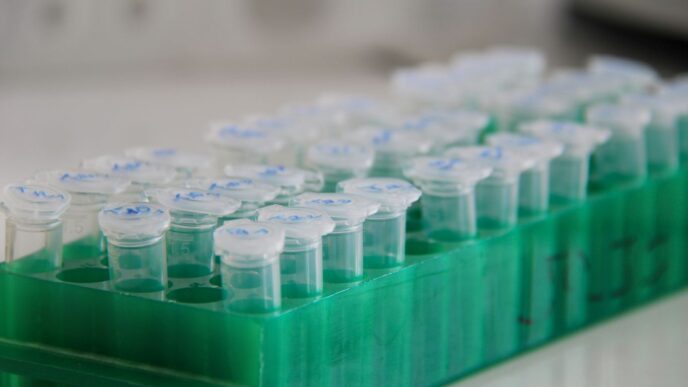It’s pretty wild how much technology has changed things, right? Healthcare is no exception. What used to take days or weeks now happens in minutes. We’re talking about everything from how doctors keep track of your health history to how they perform complex surgeries. This article looks at the 10 importance of technology in healthcare and how it’s making patient care better, faster, and more accessible for everyone. It’s a big shift, and honestly, it’s pretty exciting to see where it’s all heading.
Key Takeaways
- Electronic Health Records (EHRs) give doctors quick access to patient info, helping them spot health issues early and plan better prevention.
- Telemedicine lets patients see doctors virtually, which is super helpful for people who live far from clinics or have trouble getting around.
- Wearable tech keeps an eye on things like heart rate and sleep, allowing doctors to monitor patients from a distance.
- AI and data analytics help healthcare providers make smarter decisions by looking at lots of health information.
- Innovations like 3D printing, robotic surgeries, and VR are leading to new ways to treat patients and train medical staff.
1. Electronic Health Records
Remember the days of lugging around a giant folder stuffed with medical papers? Yeah, me neither, but I’ve heard stories. Thankfully, we’ve moved past that thanks to Electronic Health Records, or EHRs. These digital versions of a patient’s chart are a game-changer.
EHRs consolidate all your health information – from past illnesses and treatments to test results and doctor’s notes – into one easily accessible digital file. This means your doctor has a complete picture of your health, which really helps when they’re trying to figure out what’s going on and how best to treat you. It’s not just about having all the info in one place, though. It’s about how that information flows.
Here’s why EHRs are so important:
- Better Care Coordination: When different doctors and specialists can easily access your records, they can work together more effectively. No more playing telephone with your medical history!
- Improved Accuracy: Digital records reduce the chances of errors that can happen with handwritten notes or outdated information. This leads to more accurate diagnoses and safer treatment plans.
- Patient Empowerment: Many EHR systems come with patient portals. This lets you see your own health data, lab results, and even communicate with your doctor. It puts you more in the driver’s seat of your own health journey.
Think about it: before EHRs, if you moved or saw a new specialist, you’d have to track down all your old records yourself. Now, with systems that can share information, your new doctor can get up to speed quickly. This continuity of care is a huge step forward for patient safety and outcomes. It’s a big part of how we’re seeing digital health records become the standard.
2. Telemedicine
Remember when seeing a doctor meant taking time off work, driving across town, and sitting in a waiting room for ages? Yeah, me neither, because that’s mostly a thing of the past thanks to telemedicine. This is basically healthcare delivered through technology, like video calls. It’s a game-changer for folks who live far from clinics or have trouble getting around.
Think about it: you can chat with your doctor from your couch, get a prescription, or even have a follow-up appointment without leaving your house. This really took off during the pandemic, letting doctors keep seeing patients safely. It’s not just for remote areas either; even city dwellers find it super convenient. It’s a big step forward in making medical help more accessible for everyone, no matter where they are. This technology is really helping to bridge gaps in healthcare access.
Here’s why it’s so great:
- Convenience: No more travel time or waiting rooms.
- Accessibility: Great for people in rural areas or with mobility issues.
- Continuity of Care: Doctors can keep tabs on patients more easily.
- Cost Savings: Often cheaper than in-person visits for both patients and providers.
3. Wearable Technology

You know, those little gadgets we strap to our wrists or wear as patches? They’re becoming a pretty big deal in healthcare. Think smartwatches that track your heart rate, fitness bands that count your steps, or even specialized sensors that can monitor things like blood glucose levels. These devices put a lot of health information right into our hands, or rather, onto our bodies.
It’s not just about counting steps anymore. These wearables are collecting real-time data that doctors can use. For example, a continuous ECG monitor can catch irregular heart rhythms that might be missed during a short clinic visit. Or a sleep tracker can give a doctor a clearer picture of a patient’s sleep patterns, which is important for all sorts of health issues. This constant stream of data helps create a more complete picture of a person’s health outside of the doctor’s office.
Here’s a quick look at what they can do:
- Monitor Vital Signs: Heart rate, blood pressure, oxygen saturation, and body temperature.
- Track Activity and Sleep: Steps taken, calories burned, distance covered, and sleep quality.
- Detect Specific Conditions: Some devices can alert users to potential issues like falls or irregular heartbeats.
- Manage Chronic Diseases: Helping patients keep tabs on conditions like diabetes or heart disease.
Of course, there are still some hurdles. Making sure all this data stays private and secure is a big one. Plus, getting people to actually wear and use these devices consistently, especially if they’re complicated, can be tough. But the potential for proactive health monitoring is huge. It’s like having a personal health assistant constantly looking out for you.
4. Artificial Intelligence
Artificial Intelligence, or AI, is really changing the game in healthcare. Think of it as a super-smart assistant that can look at tons of medical information way faster than any human could. It’s not just about crunching numbers, though. AI is helping doctors figure out what’s wrong with patients, suggesting treatments, and even speeding up the process of finding new medicines.
For instance, some AI programs are getting incredibly good at spotting things like cancer in medical images, sometimes even better than experienced radiologists. This means earlier detection and, hopefully, better outcomes for patients. It’s also being used to sift through existing drugs to see if they can be repurposed for new diseases, which is a much faster route than developing something entirely from scratch.
Here’s a quick look at what AI is doing:
- Improving Diagnostics: AI can analyze scans and patient data to help identify diseases with greater accuracy.
- Drug Discovery: It speeds up the search for new medications by simulating how molecules interact.
- Personalized Treatment: By looking at individual patient data, AI can help tailor treatment plans for better results.
- Predictive Analytics: AI can forecast potential health risks for patients, allowing for proactive care.
It’s pretty wild to think about, but AI is helping us understand diseases and patient health on a level we couldn’t before. It’s like having a tireless researcher and analyst working around the clock to improve patient care.
5. Data Analytics
Think about all the information generated in healthcare every single day – patient records, test results, doctor’s notes, even data from those smartwatches people wear. It’s a massive amount of stuff, and most of it used to just sit there, not doing much. That’s where data analytics comes in. It’s basically the process of sifting through all that raw health data to find useful patterns and insights.
This helps us move from just guessing to making decisions based on actual evidence. Instead of relying on gut feelings, doctors and hospitals can look at what the data tells them about what works best for patients. This can mean figuring out which treatments are most effective for certain conditions, or even predicting which patients might be at risk for developing a disease down the line.
Here’s a look at what data analytics can do:
- Personalized Treatment Plans: By looking at a patient’s history, genetics, lifestyle, and even how they’ve responded to past treatments, analytics can help tailor a care plan specifically for them. It’s like getting a custom-made suit instead of one off the rack.
- Predicting Health Risks: Analytics can identify individuals or groups who are more likely to develop certain health issues, like diabetes or heart disease. This allows healthcare providers to step in early with preventative measures or lifestyle advice.
- Spotting Disease Outbreaks: By analyzing patterns in health data across populations, analytics can help public health officials detect potential outbreaks faster. This means quicker responses and better control over the spread of illnesses.
- Improving Hospital Operations: Beyond patient care, analytics can also help hospitals run more smoothly. This could involve predicting patient flow, managing resources better, or even identifying areas where costs can be reduced without affecting care quality.
It’s not just about numbers, though. A lot of important information is hidden in things like doctor’s notes or research papers, which are written in plain language. Advanced analytics can even process this unstructured text to pull out key details that might otherwise be missed. It’s a big shift, turning a flood of information into actionable knowledge that can really make a difference in how we manage health and treat people.
6. 3D Printing
It’s pretty wild to think about, but 3D printing is no longer just for making trinkets or prototypes. In healthcare, it’s becoming a seriously big deal. We’re talking about creating custom body parts, surgical tools, and even medications.
Think about it: instead of using a generic implant that might not fit perfectly, doctors can now print one that’s made specifically for a patient. This means better fits, less chance of complications, and quicker recovery times. It’s also a game-changer for planning surgeries. Surgeons can get a 3D model of a patient’s anatomy before they even step into the operating room, letting them practice and figure out the best approach. This kind of personalized approach to medical 3D printing is really changing the game.
Here are a few ways 3D printing is making waves:
- Prosthetics: Creating affordable, custom-fit artificial limbs for people who need them, especially in areas where resources are scarce.
- Implants: Printing things like bone replacements, joint implants, and even parts of the skull that are perfectly shaped for the individual.
- Surgical Guides: Making precise guides that help surgeons make accurate cuts or place screws during complex operations.
- Pharmaceuticals: Developing pills with specific dosages or combinations of drugs layered together, which could make it easier for patients to stick to their treatment plans.
It’s not just about solid objects, either. Researchers are even working on printing living tissues and blood vessels, which could eventually lead to new ways to treat burns or even grow organs for transplant. The technology is still evolving, but the potential is huge for making healthcare more tailored and effective for everyone.
7. Robotic Surgeries
Robotic surgery is pretty wild, isn’t it? It’s not like the robots are doing the whole thing on their own, but they give surgeons a serious upgrade. Think of it like having super-powered tools that are way more precise than what a human hand can manage.
These systems usually involve a console where the surgeon sits, looking at a magnified 3D view of the surgical area. Then there are the robotic arms, which hold tiny instruments and a camera. The surgeon’s hand movements at the console are translated into incredibly precise actions by these arms. This allows for smaller incisions, less blood loss, and often a quicker recovery for the patient. It’s a big deal for complex procedures, like prostatectomies or heart valve repairs, where getting into tight spots with accuracy is key.
Here’s a quick rundown of why it’s so good:
- Precision: The robotic arms can move in ways a human wrist just can’t, making delicate maneuvers much easier.
- Minimally Invasive: Smaller cuts mean less scarring and less pain after the operation.
- Better Visualization: The 3D camera gives surgeons a really clear, magnified look at what they’re doing.
- Reduced Fatigue: For long surgeries, the robotic system can help reduce the physical strain on the surgeon.
It’s still a tool, of course, and requires a skilled surgeon to operate it. But the technology is definitely changing the game for a lot of operations.
8. mHealth
You know, it’s pretty wild how much our phones have become a part of our lives, and now, they’re even helping us stay healthy. That’s basically what mHealth, or mobile health, is all about. It’s using your phone or other mobile devices to manage your health and connect with doctors.
Think about it: instead of waiting for your next appointment, you can use an app to track your blood sugar, log your meals, or even get reminders to take your medication. This kind of constant connection makes managing chronic conditions way easier for people. It’s not just for patients, either. Doctors can use these tools to keep an eye on things remotely, which is super helpful, especially if you live far from the clinic or have trouble getting around.
Here are a few ways mHealth is changing things:
- Better Patient Engagement: Apps can make health information more accessible and encourage people to take a more active role in their own care. You can find educational content, track your progress, and even join support groups.
- Remote Monitoring: Devices and apps can send vital signs like heart rate or blood pressure directly to your doctor. This means potential problems can be spotted much sooner.
- Convenient Communication: Scheduling appointments, refilling prescriptions, or asking quick questions can often be done right through an app, saving you a trip or a long phone call.
It’s still growing, but mHealth is really making healthcare more convenient and personalized for everyone.
9. Virtual Reality

Virtual reality, or VR, is really starting to make waves in how we approach healthcare. It’s not just for gaming anymore; it’s becoming a serious tool for doctors and patients. Think about it – surgeons can practice complex procedures in a totally safe, simulated environment before ever touching a real patient. This kind of training can lead to much better outcomes. In fact, some studies show VR-trained surgeons perform significantly better than those who only learned the old way.
But it’s not just for the medical pros. Patients are finding real benefits too, especially when it comes to managing pain and anxiety. Imagine being in the hospital, feeling stressed, and then putting on a VR headset that transports you to a peaceful beach or a calming forest. It sounds like science fiction, but it’s happening now. People dealing with chronic pain, or even just the anxiety before surgery, have reported feeling much better after using VR. It’s a pretty neat way to help people cope with difficult medical situations. This technology is really changing the game for medical training and patient comfort.
10. Nanotechnology
Think tiny. Like, really, really tiny. Nanotechnology in healthcare is all about using materials and devices at the atomic and molecular level to fix things inside our bodies. It’s kind of like having microscopic repair crews or delivery services working from the inside out.
One of the most talked-about uses is in drug delivery. Instead of a pill dissolving all over the place, imagine nanoparticles carrying medicine directly to the sick cells, like a targeted strike. This could mean fewer side effects and better results. We’re already seeing smart pills that can take pictures of your insides or release medication when told, sometimes even by a smartphone app. Pretty wild, right?
Beyond just delivering drugs, these tiny tools could become like microscopic surgeons, fixing problems cell by cell. There’s also work being done on smart patches that not only monitor wounds but actually help them heal faster. It’s early days, but the potential is huge.
Here’s a quick look at what nanotechnology might bring:
- Targeted Drug Delivery: Sending medicine precisely where it’s needed.
- Minimally Invasive Surgery: Tiny robots performing delicate procedures.
- Advanced Diagnostics: Detecting diseases at their earliest stages.
- Tissue Repair: Helping damaged cells and tissues regenerate.
It’s a bit like science fiction becoming reality, but with real, tangible benefits for patients.
The Road Ahead
So, looking back at all the ways technology has changed healthcare, it’s pretty clear this is just the beginning. From making appointments easier with apps to doctors using advanced tools to figure out what’s wrong faster, things are moving quickly. It’s not just about fancy gadgets, though. It’s about making sure everyone, no matter where they live or how much money they have, can get the care they need. Technology is helping cut down on paperwork too, freeing up doctors and nurses to focus on what really matters – us. As these tools keep getting better, we can expect even more improvements in how we stay healthy and get treated when we’re sick. It’s an exciting time for medicine, and it’s all thanks to the smart use of technology.
Frequently Asked Questions
How do electronic health records help doctors?
Electronic health records, or EHRs, give doctors quick and easy access to a patient’s entire medical past. This helps them spot health problems early and create better plans to keep people healthy.
What is telemedicine and why is it useful?
Telemedicine is when doctors use technology, like video calls, to see and talk to patients from far away. It’s super helpful for people who live in rural areas, can’t easily travel, or want the convenience of getting care at home.
How does wearable technology help with health?
Wearable devices, like smartwatches, have sensors that track important body info such as heart rate and sleep. Doctors can use this information to keep an eye on your health even when you’re not in the office.
Can artificial intelligence help in healthcare?
Yes! AI can help doctors find diseases faster, suggest new medicines, and even help with tasks like scheduling. It’s like having a super-smart assistant for healthcare.
What is mHealth?
mHealth stands for mobile health. It involves using apps on your phone or other mobile devices to manage your health, like setting appointment reminders or accessing health information.
How is 3D printing used in healthcare?
3D printing is used to create amazing things like artificial body parts, skin, and even custom-made pills. It’s helping doctors create personalized treatments and provide life-changing solutions for patients.














